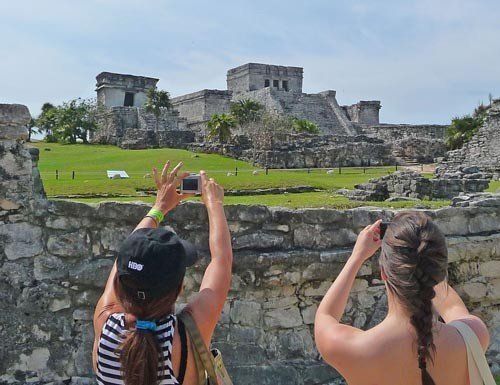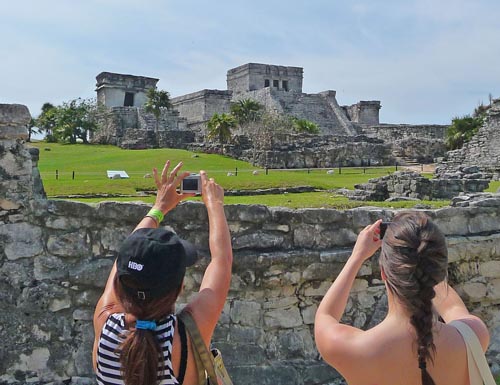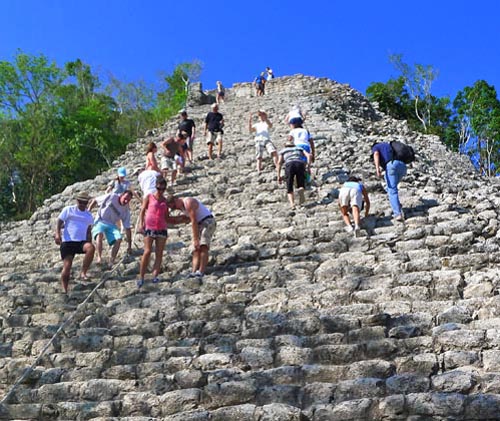
They're checking out Chichen Itza, packing Palenque and tooling around Tulum: A whopping 10.6 million tourists explored Mexico's 183 publicly open archaeological sites last year, according to the country's National Institute of Anthropology and History. And the visitor count is expected to soar through the roof in 2012.
Most of the sites are the ruins of Mayan city-states that once ruled the roost over eastern Mexico's Yucatan Peninsula. A good number of visitors to the sites are
vacationers staying at the hotel-resorts of Cancun and the Riviera Maya on a 100-mile-long strip of the Yucatan's powdery Caribbean beaches.
Tulum (City of the Wall)
One of the big draws for archaeo-tourists is the clifftop city of Tulum, perched like a guard over an ancient seaport at the southern end of the resort strip.

Tourists snap images of El Castillo, Tulum's landmark temple.
Tour guides say the city must have lit up like a fireball in the morning when the first rays of the sun began bouncing off its crimson-colored temples, shrines and towers -- perhaps explaining why it was originally called Zama, or "City of the Dawn." It must have been a show-stopper at night, too. Had the Spanish sailors who first spotted the city in 1518 sailed by after sundown, they'd have been treated to the sight of its 60-plus structures shimmering in the glow of torches atop pyramids and ceremonial towers.
Among eye-popping buildings along Tulum's cobbled lanes are the magnificent Temple of El Castillo ("The Castle"), the Temple of the Descending God (featuring an upside-down figure of the Mayan god of the bees) and a cliffside sanctuary called Temple of the Winds.
The city was renamed Tulum when a wall was built to protect its three land sides from invasions by other tribes. For hundreds of years, Tulum thrived as a trading port for the much larger neighboring city of Coba.
Coba (Waters Stirred by the Winds)
About an hour's ride inland from Tulum are the ruins of the Mayan super-city of Coba. Climb the 120 steps of the Nohoch Mul pyramid there -- the tallest in the Yucatan, spiraling up nearly 140 feet -- and you'll get a dazzling view of this immense city.

Pyramid of Nohoch Mul is some 140 feet high.
Besides five lakes around the site (hence the "waters" in its name), archaeologists say Coba could have had as many as 20,000 structures including pyramids, palaces, government offices and homes. They believe anywhere from 20,000 to 50,000 people lived there.
About 1,100 years ago, Coba's role as the Yucatan's top city-state began giving way to a tough new competitor in the north, Chichen Itza. Coba was abandoned at the time the Spanish conquered the Yucatan around 1550.
Chichen Itza (Mouth of the Well of the Itza)
The most-visited Mayan archaeological site, Chichen Itza is a ride of three or so hours inland from Cancun at the northern end of the Caribbean resort strip.
Towering over the city is its iconic Pyramid of Kukulkan, one of the New Seven Wonders of the World. The 91-step building's grounds are particularly packed during the two equinoxes when the setting sun creates an amazing spectacle: the shadow of a feathered serpent (representing Kukulkan, the Mayan god of gods) slithering down one of the pyramid's staircases to join up with a carved snake head at the bottom.
Make sure to check out the much-photographed Temple of the Warriors, El Caracol (a rounded observatory), the ball court -- where losing teams lost a lot more than the game -- and a huge well called a cenote (possibly the "mouth" of earlier rulers of the city, the Itzas). It's said that maidens weighed down by gold, jade and carved seashells were tossed into the well to please the gods.
Apocalypse coming in December?
Sparked by the end of the last cycle of the 5,126-year Mayan calendar this year on Dec. 21, the archaeo-visitor count is expected to soar over the coming months as more and more end-of-the-world stories make it into the news media.
"Doomsday predictions make great copy," says historian Jaime Capulli in Mexico City, "But most likely the old-time Mayans simply never expected anyone to be around all those years later -- and just didn't bother to add another cycle."
More info: Visit the Mexico Tourism Board, the Riviera Maya Destination Marketing Office and the Cancun Convention and Visitors Bureau.
All images by Bob Schulman